Coneheads Were Real - and Natural
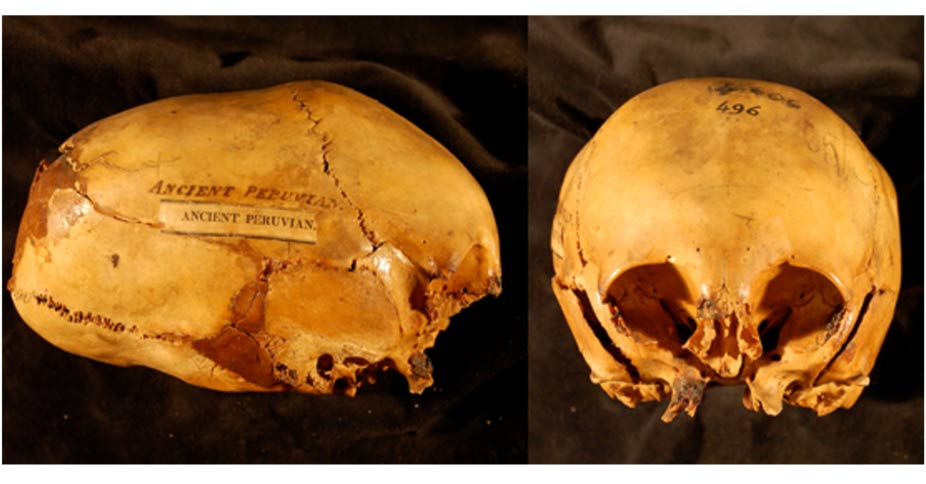
Elongated Skulls in Utero:
A Farewell to the Artificial Cranial Deformation Paradigm?
Elongated skulls are usually explained in terms of head-binding or artificial cranial deformation. This paradigm emerged in the first half of the 19th century as a way of explaining unusual skulls discovered in Europe and South America, in places such as Crimea and Peru respectively. The main idea behind the head-binding paradigm is that ALL elongated skulls are a result of intentional modification of the form of the skull by applying external pressure. In other words, ALL elongated skulls are merely deformed ‘normal’ skulls similar to those of modern humans.
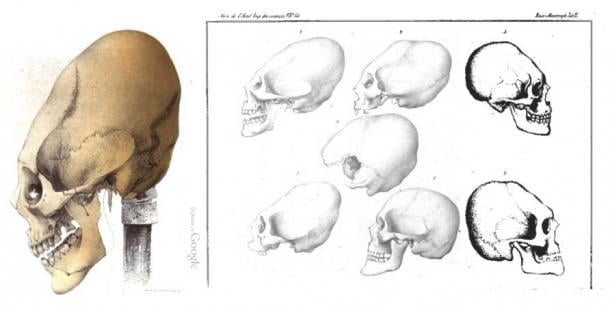
Elongated Skull from Crimea and other parts
of the worlds, Baer 1860
What evidence could challenge this paradigm? Right – the existence of fetuses with elongated skulls, i.e. evidence that such skulls already had an elongated shape in utero, before any head-binding was possible. Do we have such evidence? Yes, we do! Moreover, this evidence has been known to the academic community for over 163 years!
Rivero and Tschudi in Peruvian Antiquities (1851 Spanish, 1853 English) argue that the protagonists of the artificial cranial deformation hypothesis are mistaken, since they had only considered the skulls of adults. In other words, the hypothesis fails to take into account the skulls of infants and, most importantly, foetuses which had similar elongated skull shape.
It is worth quoting Rivero and Tschudi:
“We ourselves have observed the same fact [of the absence of signs of artificial pressure – IG] in many mummies of children of tender age, who, although they had cloths about them, were yet without any vestige or appearance of pressure of the cranium. More still: the same formation of the head presents itself in children yet unborn; and of this truth we have had convincing proof in the sight of a foetus, enclosed in the womb of a mummy of a pregnant woman, which we found in a cave of Huichay, two leagues from Tarma, and which is, at this moment, in our collection [my emphasis – IG].
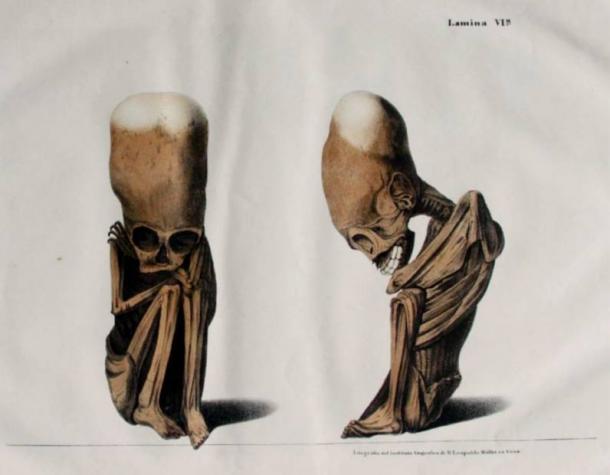
Lithograph by D. Leopoldo Mueller from the
Spanish 1851 Edition of Peruvian Antiquities
Professor D’Outrepont, of great Celebrity in the department of obstetrics, has assured us that the foetus is one of seven months’ age. It belongs, according to a very clearly defined formation of the cranium, to the tribe of the Huancas. We present the reader with a drawing of this conclusive and interesting proof in opposition to the advocates of mechanical action as the sole and exclusive cause of the phrenological [i.e. cranial – no negative connotation at that time - IG] form of the Peruvian race.
"The same
proof is to be found in another mummy which exists in the museum of Lima, under
the direction of Don M. E. de Rivero."

Mark Laplume’s reconstruction of the Rivero and Tschudi’s foetus
Elongated skulls of infants were available to European researchers as early as 1838. The skulls of “Ancient Peruvians” were also in Samuel Morton’s collection in Philadelphia.
Two elongated infant skulls, which Rivero and Tschudi mention in Peruvian Antiquities were discovered and brought to England by Captain Blankley and presented to the Museum of the Devon and Cornwall Natural History Society in 1838. Dr. Bellamy provided a detailed description of these skulls in 1842, suggesting that they belonged to two infants – male and female, few months and about a year old respectively. He indicated substantial structural differences from those of “normal” infant skulls and the absence of the signs of artificial pressure, as well as their similarity to other “Titicacan” skulls in the Museum of the College of Surgeons in London.
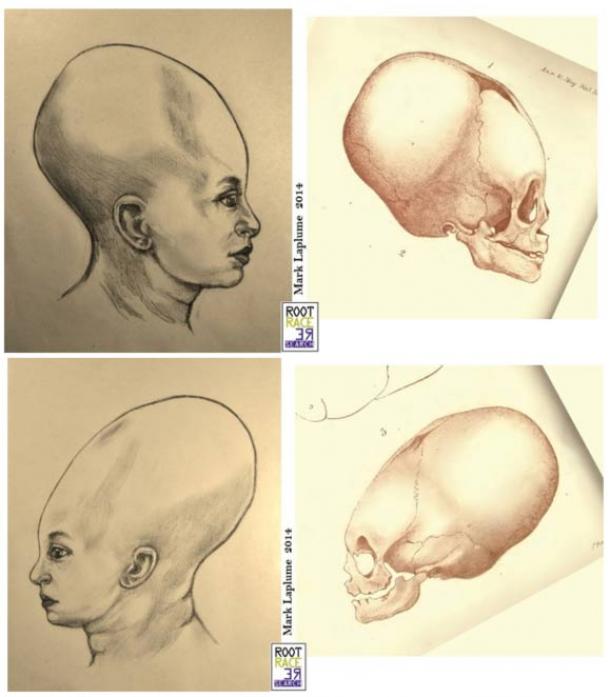
Lithographs of the skulls by J. Basire from
Bellamy's article (1842) and Mark Laplume's artistic reconstructions
The evidence of elongated skulls present in fetuses and children had lead Rivero and Tschudi, Bellamy, Graves and others to a hypothesis that these skulls belonged to an extinct race of people, who left their legacy on the populations who succeeded them as a practice of artificial cranial deformation. I discuss this hypothesis in more detail in The Looming Collapse Of The Artificial Cranial Deformation Paradigm. Part 1. Un/Born With Elongated Head and Part 2. Naturally Elongated.
The question now is how it happened that the cranial deformation paradigm became so prevalent? The answer to a large extent consists in the authority of Morton’s expert opinion and his extensive collection of skulls, which is now located in the University of Pennsylvania Museum of Archaeology and Anthropology. His influence was significant enough at the time to close the debate on elongated skulls for the next century and a half; until independent researchers, and I would like to mention Robert Connolly (who popularized elongated skulls in mid 1990s) and Brien Foerster, in particular, started to raise questions about the validity of the cranial deformation hypothesis by locating and showing elongated skulls to the public interested in finding out the true story of human origins.

Lithographs by John Collins, 1839 from Samuel
Morton's 'Crania Americana'
In Crania Americana Morton offered a description of peculiar elongated skulls which differed from the elongated skulls produced by various artificial means. He suggested that the territory of Peru and Bolivia was previously inhabited by the race of “Ancient Peruvians”.
“I have been so fortunate as to have the examination, in my own and other collections, of nearly one hundred Peruvian crania: and the result is, that Peru appears to have been at different times peopled by two nations of differently formed crania, one of which is perhaps extinct, or at least exists only as blended by adventitious circumstances, in various remote and scattered tribes of the present Indian race. Of these t wo families, that which was antecedent to the appearance of the Incas is designated as the Ancient Peruvian, of which the remains have hitherto been found only in Peru, and especially in that division of it now called Bolivia.”
Although Ancient Peruvians had naturally elongated skulls, Morton concluded that they further tried to articulate this feature by head binding. This is an interesting observation in itself, since it raises a question why a race with naturally elongated skulls would aspire to further elongate them. Perhaps they were also preceded by a race whose skulls were even more elongated?
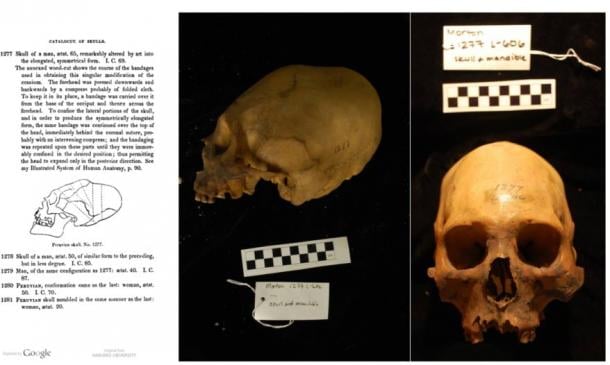
Morton Collection, Skull #1277, University of
Pennsylvania Museum of Archaeology and Anthropology, the Open Research Scan
Archive at Penn, and Janet Monge and P. Thomas Schoenemann; image in front from
Meigs, 1857
Subsequently, Morton changed his opinion and started to consider all elongated skulls as an exclusive result of head-binding. However, in light of Rivero and Tschudi’s fetuses with elongated skulls, as well as hundreds of infant and children elongated skulls which are now available to researchers, it is necessary to open the debate about “Ancient Peruvians” and their counterparts (see my interview with Mark Laplume) in other part of the world.
Accordingly, it is necessary to revisit Morton’s original encounter with elongated skulls. This is how he originally described cranial features of Ancient Peruvians:
“[The head] is small, greatly elongated, narrow its whole length, with a very retreating forehead, and possessing more symmetry than is usual in skulls of the American race. The face projec ts, the upper jaw is thrust forward , and the teeth are inclined outward . The orbits of the eyes are large and rounded, the nasal bones salient, the zygomatic arches expanded; and there is a remarkable simplicity in the sutures that connect the bones of the cranium.”
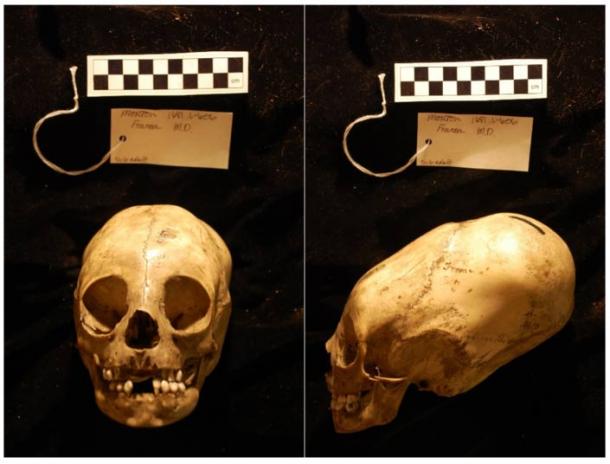
Morton Collection, Skull #1681, University of
Pennsylvania Museum of Archaeology and Anthropology, the Open Research Scan
Archive at Penn, and Janet Monge and P. Thomas Schoenemann
Given that there are at least two mummies containing foetuses with elongated skulls, in addition to hundreds of infant and children with elongated crania (see Children Of The ‘Elongated Skulls’ As A Challenge To The ‘Artificial Cranial Deformation’ Theory and RootRaceResearch), a priority task for the academic community would be to identify the physical location of the mummies and proceed to DNA analysis, which is currently done by independent researcher and enthusiasts who lack infrastructural and financial resources and face significant obstacles in obtaining necessary permissions. It is worth noting that we deal with very old DNA, the analysis of which is a complex and expensive procedure.
Featured image: Morton Collection, “Ancient Peruvian” skull #496, University of Pennsylvania Museum of Archaeology and Anthropology, the Open Research Scan Archive at Penn, and Janet Monge and P. Thomas Schoenemann
References:
Von Baer, Karl Ernst. Makrokephalen im Boden der Krim und Österreichs. St. Petersburg. 1860.
Bellamy, P. F. A brief Account of two Peruvian Mummies in the Museum of the Devon and Cornwall Natural History Society. in ‘Annals and Magazine of Natural History’. Vol. X. October 1842.
Graves, Robert J. Remarkable Skulls Found in Peru. No.15 of the Dublin Journal of Medical and Chemical Sciences. 1835.
Meigs, J. Aitken. Catalogue of Human Crania in the Collection of the Academie of Natural Sciences of Philadelphia: Based Upon the Third Edition of Dr. Morton's " Catalogue of Skulls". Philadelphia. 1857.
Morton, Samuel George. Crania Americana; or, A Comparative View of the Skulls of Various Aboriginal Nations of North and South America. To which is Prefixed an Essay on the Varieties of the Human Species. London. 1839.
Rivero, M.E., Tschudi, J.D. Antigüedades peruanas. Vienna, 1851 (Spanish). Rivero, M.E., von Tschudi, J.J. Peruvian antiquities. New York, 1853 (English).
Unravelling the Genetics of Elongated Skulls –
Transcript of Interview with Brien Foerster
See video below
Here we present the transcript of an interview conducted between April Holloway of Ancient Origins, and Brien Foerster, researcher and author, on the subject of elongated skulls in Paracas. In particular, the interview covers a recent announcement that was made in relation to genetic testing that was carried out on one of the Paracas skulls.
April: Brien, thanks very much for joining Ancient Origins for this interview about the elongated skulls in Paracas. Some of our viewers will have already seen an interview we had some time ago about research around elongated skulls, but I am really enthusiastic about this interview because it relates to a recent announcement you made relating to some genetic testing that has been done on one of the skulls found in Paracas. To begin with, could you give just a little bit of background about the Paracas skulls in particular and what makes them different from other elongated skulls that have been found?
Brien: Well, what’s kind of intriguing is if you look on the internet at any photo website, and if you put in something like ‘alien skull’ or ‘human-hybrid skull’, quite often the Paracas skulls show up, predominantly because they are so large in size, some of them are very natural looking, and also there are so many of them that have been found, which is quite intriguing.
April: So would you say that some of the features that these skulls have ruled out the possibility of cranial deformation, processes like head flattening or head binding, which are known to have happened in other cases of elongated skulls?
Brien: Well that is the curious point in that cranial deformation is known to have occurred in many different parts of the world, most prominently about 2,000 years ago, from the Middle East, even Melanesia, and Central America, but because I have been intimately engaged with the elongated skulls at Paracas, and the Paracas culture in general that died out 2,000 years ago, I have had the opportunity to look in person at numerous of the skulls, as well as hundreds which are in collections all around the world. And some of them I would say, possibly between 5 – 10% of them, do not show obvious signs of cradle boarding or other forms of cranial deformation, which generally tends to create flat surfaces, either in the forehead or the back of the head. Some of these literally look like they are natural in appearance.
April: I have also heard that some of the other features include increased volume and increased weight compared to other skulls. Is that not something that could also happen as a result of head flattening, where through the process of binding, the size actually increases, or is that absolutely not possible?
Brien: Well from the Doctors that I have spoken to, they have said that you can alter the shape of the skull but you cannot increase the size of the skull. The skull is genetically predetermined to have a certain volume and so it is much like… an analogy I have is pottery where if you have a piece of green ware which is a pot which is not quite dried yet, you can alter its shape, but you can’t change the volume of it itself. Some people have stated that the reason why the Paracas could have had denser skulls or be heavier etc. is the result of their diet or malnutrition or whatever, and the thing is that they had an incredible diet of seafood as well as terrestrial plants. They probably actually ate better than most of us do today.
April: So the study of these skulls is becoming a lot more interesting now that we have the technology for extracting DNA and analysing DNA. Before any testing was undertaken, did you have any theories yourself about what might be found?
Brien: Well I didn’t want to conjecture anything. Of course, I have had many different ideas but I’ve been waiting for actual DNA analysis and that has taken an incredibly long time, mainly due to lack of funding and also finding a geneticist who is open to studying this, doing it at a fraction of the normal cost that it would cost commercially, and importantly, we wanted to do this independently because going through any governmental or private foundation would probably result in the results either being deleted or altered, or being kept for purposes other than my intent, and my intent simply is to find the truth as to who these people were.
April: Can you explain a bit about the testing process that actually took place or has taken place so far?
Brien: Well it is a very complex process and most people don’t realise this because they think: ‘Well, DNA testing is quite simple now, I can go and have a blood sample extracted and be told within a few days all of my genetic ancestry’, but what you have to take into account is that the last of the Paracas died 2,000 years ago, and so you are talking about 2,000 years of the degeneration of the material. The late Lloyd Pye, who I was acquainted with very personally and professionally because of his fascination with this, his analogy is that to take a sample and analyse it from somebody who is living is the equivalent of looking at or studying a crystal bowl because it is complicated and intact. And then he said the equivalent of ancient DNA is taking that crystal bowl and throwing it on a concrete floor because it becomes shattered into tiny little segments. So it is only the most recent sophisticated, extremely expensive DNA analysing equipment that can take all of those tiny segments and put them back together. So it has been very difficult who would pursue that. We actually have two different geneticists that worked but it happened to be this one who has had samples for more than two years who has given me this initial result which complete shocked him.
April: So the thing most people really want to know is what exactly was found in that initial result?
Brien: Basically what I can say is that he speculates that there are segments of the DNA of the Paracas which do not match anything in GenBank, which is the genetic database located in the United States that contains all known genetic DNA information. So he said there are segments which don’t seem to be any haplotype of human that we know of, also not related to Neanderthal or any other human-like being that has been studied so far.
April: Quite incredible really. Now you have emphasised that this is phase one, or stage one of the testing. What then is the next stage after this one? Is it possible that this result is contaminated or is not accurate and that further stages may reveal something different?
Brien: It is possible. However, this person who lives in the United States and has a doctorate, he does a lot of contract work for the US government so clearly the government wouldn’t choose someone who is flaky or sensationalist. He has taken a lot of time. It has been more than two years for him to give us the initial result of one sample so far. But he does have samples from three different skulls from Paracas and so what I am hoping is, and the reason why I released this information, is to try to generate interest from the public so that we can do a fundraiser in order to be able to study the other two skulls, as well as other samples from the three skulls themselves, so that we can replicate the tests as many times as possible to see whether or not this is an anomaly or whether it is something which is truly mind-blowing, I guess is the term.
April: Yes, exactly. Is it possible, the fact that it doesn’t match anything in the GenBank, could it be that this is just a one-of-a-kind mutation, a mutation that hasn’t been seen before, and is just unique to that particular race of people?
Brien: It could be, but again the whole study is so new and the Paracas are very mysterious people. No one has really studied them for about seventy years. The people that study them now study their textiles, but the whole idea, the fact that their skulls seem to be of a different shape, has been dismissed in general as being cranial deformation, but in fact nobody knows where the Paracas people came from. They lived on the coast of Peru and through my studies I believe that there is a certain percentage of their ancestry that comes from another part of the world because they also, amongst the royalty, seem to have had reddish-brown hair which is not a native American characteristic, and they were reasonably tall. Some specimens we found were 5’10 to 6 feet to even taller in height and that is quite atypical of a Native American person 2,000+ years ago living on the coast of Peru.
April: So what is your opinion about these findings. Do you have a view about what this actually means, this result?
Brien: The theory I am developing is that the Paracas are a mix of different types of people. The area they chose to live 2,000 years ago was much lusher than it is now, it would have been a perfect place for a society to live in terms of food production. The fact that they had totora reeds, and still have totora growing on the coast of Peru, meant that they were capable of building not only little boats, but probably large ships out of reeds. They had cotton to make sails and they could have been great seafarers. I also believe that the famous Nazca people, who also occupied the area after the demise of the Paracas, could literally have wiped the Paracas culture out and absorbed their knowledge, absorbed some of their people who would have interbred with the Nazca. But elongated skulls disappear in the Paracas area 2,000 years ago and that corresponds with the arrival of the Nazca who were a very war-like people.
April: So you say a different mix of people. Now the thing on everyone’s mind is, are these skulls alien? Are they extra-terrestrial? When you say a different mix of people, do you think there is a possibility that a race of beings did arrive in this part of the country and perhaps bred with humans? What’s your view on that?
Brien: Well, I am open to the idea. The thing is, I don’t want to go too far in that direction yet because again, we’ve only had an initial result, but due to the fact that the geneticist has found segments of DNA that don’t correspond with anything, I think it is doubtful that they are a separate breed of humanity, because where would they have come from? Again, the strange thing is this predominant aspect of these elongated skulls amongst the royal family is very, very odd. So future sampling, future results will either reinforce or dismiss the result we have. I think we are looking at something very intriguing and I don’t dismiss the idea of there having been off-planet intervention or something, and Lloyd Pye was very strong with this idea, he simply said ‘these are not human beings’.
April: Speaking of Lloyd Pye, are you doing anything to carry forward the research he was doing or do you know what is being done about the research that was being undertaken by Lloyd Pye?
Brien: Yes, several months before his death, he passed the Starchild skull and the information on to a group of people because he knew he was ill, he wasn’t sure if he would recover, and so they are doing major fundraising. They have done a lot of genetic analysis, which people can see on Lloyd’s website. The thing is people really have to spend the time to read all of the information because you can’t get a full picture of what the Starchild is or was through 5 or 10 minutes of reading. There has been a lot of money and effort spent on Starchild and the unfortunate thing is that there is only one Starchild, whereas there are hundreds of Paracas skull, it’s amazing. And the access is quite astonishing too because being related with this Paracas History Museum, I have assisted in building up the collection to 40 skulls so far and we are very open to researchers from around the world coming, whether they are doctors or geneticists or whoever, because we honestly want to get to the bottom of this and any outside help is very greatly appreciated.
April: Well I guess the quantity really opens up the possibility to replicate these results and to keep everyone happy by doing those extra studies, having different researchers, using different skulls because then whatever the result will be, will be a lot more convincing after all that replication has been done.
Brien: Yes, that’s exactly it. And any scientific test means that you have to be able to replicate it, and that’s why again this is an initial, you could even call it a teaser result, that I sent out to the public. Also a number of individuals assisted me in raising $7,000 to do some of the testing and I wanted them to know after 2 years that we actually did have something, that the money wasn’t absconded or blown on anything. It 100% went into it. We also have another geneticist working on completely other samples, that’s Dr Melba Ketchum from Texas who, of course, is embroiled heavily in Big Foot studies, which she has got a lot of flack from. But I still believe in her and there may be another one or two genetic study organisations that may come on board with this and so the more that do the analysis and the more cross-referencing we can do, the better for this whole project.
April: There are a lot of people out there who are sceptical. They do question, or they want to see these results first-hand on paper, they want to know the name of the geneticist, the name of the institution, and they do become suspicious when some of these details aren’t yet available, how would you address those concerns?
Brien: Well I have actually spoken to the geneticist about it and he said that he will be willing to address the public about this, but not after one test, because it is too easy for sceptics or whoever to rip his information apart and so as a scientist he wants to make sure that he’s done several replications and then when he is comfortable, then he will come forward himself and discuss what it is that he believes we are looking at.
April: Ok that’s great, that’s really positive. So moving forward from here, what’s the time scale relating to further testing and also the fundraising process. If someone did want to get involved in this, what could they do?
Brien: At the moment, I have been in discussions with someone who wants to set up and Indiegogo campaign about this and I have been discussing with him for about 5 months but the timing hasn’t been right because we’ve been preoccupied with other things. So probably within the next 2 or 3 months we will set up a campaign, very specifically targeted to very specific things, we will have a complete list where any funds will go, completely itemised. I will get nothing from it, just as I have received nothing financially from the previous fundraising that we did, and other samples have recently gone to the geneticist from a third party and I am still waiting for some kind of result from Dr Melba Ketchum. She has tried to actually get at least one, if not more, laboratories in the US to do complete genome studies which is very complicated and technically would cost an absolute fortune, upwards of at least $100,000 so we are hoping that other geneticists will be able to volunteer their time and the use of their equipment for the good of, basically we are doing this for the good of humanity, not for any kind of personal benefit.
April: Yes, I mean the knowledge is incredibly important, regardless of what these skulls end up being, human or otherwise, it is still important for unravelling the history of our past. These are obviously an incredibly mysterious group of people.
Brien: Well definitely. The things is that since elongated skulls have also been found amongst the Olmecs of Mexico, also in, people have said Russia, it’s not really Russia, it’s actually the area of Georgia, and in that area there are quite a number of elongated skulls that have been found there that date back about 2,000 years. And actually, I have been mapping where this process has existed all over the world and so what I am trying to do is to set up some kind of concept of migration pattern or, in fact, were these different groups genetically related? We don’t know yet, it is an ongoing procedure but I am very thankful that you wanted to cover this story at this time because we are at the beginning and any time that I get more information I am more than willing to share it with you.
April: Thanks very much Brien, we really appreciate you informing us of everything going on and we really look forward to the updates that you provide as things progress.
Brien: Thank you and your organisation. Ancient Origins, is a phenomenal success. I am very much a fan, many other people are, you are growing very rapidly and it is wonderful that such a group as yourselves are presenting this information to a global audience because in the past it’s always been little small groups of people trying to do what you are attempting and you are doing an incredibly good job at it.
April: Thanks very much, really appreciate it.
From Ancient Origins @ http://www.ancient-origins.net/unexplained-phenomena/elongated-skulls-utero-farewell-artificial-cranial-deformation-paradigm-002526 and http://www.ancient-origins.net/news-evolution-human-origins/initial-dna-analysis-paracas-transcript-399284
For more information about elongated skulls see http://nexusilluminati.blogspot.com/search/label/elongated%20skulls
- Scroll down through ‘Older Posts’ at the end of each section
Hope you like this
not for profit site -
It takes hours of work every day by
a genuinely incapacitated invalid to maintain, write, edit, research,
illustrate and publish this website from a tiny cabin in a remote forest
Like what we do? Please give anything
you can -
Contribute any amount and receive at
least one New Illuminati eBook!
(You can use a card
securely if you don’t use Paypal)
Please click below -
Spare Bitcoin
change?
For further enlightening
information enter a word or phrase into the random synchronistic search box @
the top left of http://nexusilluminati.blogspot.com
And see
New Illuminati – http://nexusilluminati.blogspot.com
New Illuminati on Facebook - https://www.facebook.com/the.new.illuminati
New Illuminati Youtube Channel - http://www.youtube.com/user/newilluminati
New Illuminati on Google+ @ https://plus.google.com/115562482213600937809/posts
New Illuminati on Twitter @ www.twitter.com/new_illuminati
New Illuminations –Art(icles) by
R. Ayana @ http://newilluminations.blogspot.com
The Her(m)etic Hermit - http://hermetic.blog.com
DISGRUNTLED SITE ADMINS PLEASE NOTE –
We provide a live link to your original material on your site (and
links via social networking services) - which raises your ranking on search
engines and helps spread your info further! This site is published
under Creative Commons Fair Use Copyright (unless an individual article or
other item is declared otherwise by the copyright holder). Reproduction for non-profit use is permitted & encouraged,
- if you give attribution to the work & author. Please include a
(preferably active) link to the original (along with this or a similar notice).
Feel free to make non-commercial hard (printed) or software copies or
mirror sites - you never know how long something will stay glued to the web –
but remember attribution!
If you like what you see, please send a donation (no amount is too
small or too large) or leave a comment – and thanks for reading this far…
Live long and prosper! Together we can create the best of all possible
worlds…
From the New Illuminati – http://nexusilluminati.blogspot.com
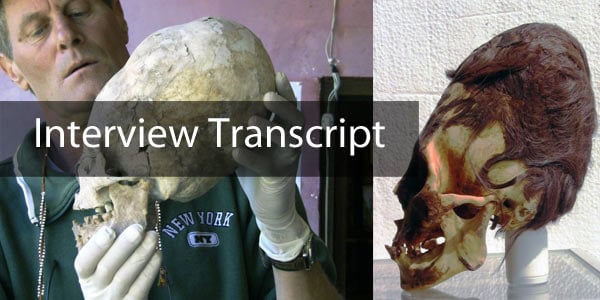
Most of what is stated here about the STORY of the elongated skulls is based entirely on hearsay. There are in fact a few anomalies and or freaks of nature, but only a few... Most of what is written and or posted here at this site is intentionally laid out ENTERTAINMENT set up to distract people away from the fleecing they're being faced with right NOW... These are very entertaining fictions designed to keep you fixated within your imaginations as the gypsy thieves surround you with their mesmerism as they're hands go into your pockets. Are you in a state of conflict? Are you living in a war torn area? Is entertainment your great escape? Do you realize that you're being played like a gypsy fiddle? This is one example of bogus information being passed off as esoteric knowledge. The fact of the matter is that you don't have any FACTS because you fail to acknowledge your own nature as you ignore the mirrors to your own existence and the solutions to your many problems because you are in perpetual conflict about what is real and what is Alice's Wonderland.... All political structures are based entirely upon easily repudiated opinions, hoaxes, false flags, and the fine art of story telling. Yes, what we have here is a fine bit of fiction for your eyes only! LOL
ReplyDeleteBelieve it or not the human mind is capable of dealing with more than one thing at a time. This material can hardly be characterised as escapism. Only someone with little intellect and/or imagination can fail to see the relevance of an altered human species living among us - as leaders - in the not-too-remote past. Much of today's ephemera ("news") will be gone tomorrow; not the reality and implications of these skulls.
DeleteYou may post your own material here if you like instread of denigrating fine content. There is a chatboard below. Use it to share your 'news'.
It's all about the "imagination" of false idols i.e. (elongated skulls), in this article, illuminator! Not necessarily "escapism," but could be a clever way to cipher more irrelevant and yes, entertaining OPINION articles through an intentional hiding and or mixing together of facts with fictions.
ReplyDelete